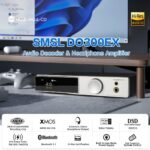You’re about to take a sneak peek into the captivating world of high-resolution music production. In this article, we’ll be pulling back the curtain to reveal the intricate process that goes into creating audio masterpieces of the utmost clarity and detail. From the meticulous selection of top-notch equipment to the delicate balancing act of capturing each instrument’s tone, you’ll gain an insider’s perspective on the hidden artistry behind high-resolution music production. Get ready to uncover the secrets that make your favorite tracks come alive like never before.
Understanding High-Resolution Music
Definition of High-Resolution Music
High-Resolution Music, commonly referred to as Hi-Res Music, is an audio format that provides a higher level of audio quality compared to standard audio formats. It aims to reproduce the sound as accurately and faithfully as possible, capturing even the tiniest details and nuances of the original recording. Hi-Res Music has a greater dynamic range, wider frequency response, and higher bit depth, resulting in a more immersive and realistic listening experience.
Differentiating High-Resolution Music from Standard Quality
High-Resolution Music stands out from standard quality music due to its superior audio characteristics. Standard audio formats, like MP3 and CD-quality audio, are typically compressed, resulting in loss of some audio details. High-Resolution Music, on the other hand, is usually presented in uncompressed or lossless formats, preserving the original audio quality. Standard quality music often has a limited dynamic range and frequency response, which can lead to a loss of depth and realism in the sound. High-Resolution Music, with its extended dynamic range and wider frequency response, presents a more accurate representation of the original recording.
Brief History of High-Resolution Music
The journey towards High-Resolution Music began in the early days of digital audio. As technology improved, there was a demand for higher audio quality. In the late 1990s, the emergence of the Super Audio CD (SACD) and DVD-Audio formats offered consumers a taste of High-Resolution Music, but adoption was limited due to factors such as high costs and compatibility issues. However, with the rise of digital downloads and streaming services, High-Resolution Music has enjoyed increased popularity and accessibility in recent years. The development of improved audio codecs, audio interfaces, and audio gear has contributed to the growth of the High-Resolution Music market.
The Transition to High-Resolution Music Production
Old vs New Techniques
The transition from standard quality music production to High-Resolution Music production involves a shift in techniques and technologies. Traditional recording and mixing techniques may not fully utilize the capabilities of High-Resolution Music. With High-Resolution Music production, there is a need for specialized equipment and a greater focus on capturing the smallest details. engineers and producers must adapt their skills and techniques to take advantage of the enhanced audio quality.
Innovative Technologies in High-Resolution Music
High-Resolution Music production has benefited greatly from advancements in technology. Improved microphones, preamps, and analog-to-digital converters capture the nuances of the performance with exceptional accuracy. Additionally, the development of high-resolution audio interfaces, capable of handling higher bit depths and sampling rates, ensures the integrity of the audio signal throughout the production process. These technologies have revolutionized the way music is recorded and produced, allowing for a more faithful reproduction of the original performance.
The Role of Internet in High-Resolution Music Production
The internet has played a significant role in the growth and accessibility of High-Resolution Music production. With the rise of cloud storage and file sharing services, it has become easier for musicians, producers, and engineers to collaborate remotely on High-Resolution Music projects. Online forums and communities have emerged, where professionals can exchange knowledge and share best practices for High-Resolution Music production. Streaming platforms and online stores dedicated to High-Resolution Music have also made it easier for consumers to access and enjoy the higher quality audio.
Recording and Mastering in High-Resolution
Overview of Recording in High-Resolution
Recording in High-Resolution involves capturing the audio signal at a higher bit depth and sampling rate. This allows for a more accurate representation of the original performance and provides more headroom for post-processing and editing. High-quality microphones and preamps are crucial for capturing the smallest details, while high-resolution audio interfaces ensure the integrity of the audio signal during the recording process. Careful consideration should be given to the recording environment to minimize unwanted noise and interference.
Process of Mastering High-Resolution Tracks
Mastering High-Resolution tracks involves the final preparation of the audio for distribution. The mastering engineer takes the individual recorded tracks and applies various techniques to enhance the overall sound. This includes adjusting the frequency response, optimizing the dynamic range, and ensuring a consistent volume level across all tracks. High-Resolution mastering requires attention to detail to preserve the integrity of the audio and bring out the best possible sound that High-Resolution Music has to offer.
Benefits of High-Resolution Recording and Mastering
High-Resolution recording and mastering offer several benefits. The higher bit depth and sampling rate capture more audio information, resulting in a more life-like and immersive sound. The extended dynamic range allows for greater contrast between the softest and loudest parts, enhancing the overall listening experience. High-Resolution Music also provides more flexibility in post-production and editing, allowing for precise adjustments and corrections without compromising the audio quality.
Key Equipment in High-Resolution Music Production
Important Devices in High-Resolution Music Production
Several key devices play a crucial role in High-Resolution Music production. High-quality microphones, capable of capturing the smallest details with accuracy, are essential. Preamps and analog-to-digital converters ensure the integrity of the audio signal during the recording process, while high-resolution audio interfaces facilitate the transfer of the audio to the computer for further processing. Monitoring speakers and headphones with a flat and extended frequency response are essential for accurate playback and mixing.
Exploring High-Resolution Music Production Software
High-Resolution Music production software provides the tools necessary for recording, editing, and mixing High-Resolution audio. Digital audio workstations (DAWs) like Pro Tools, Logic Pro, and Ableton Live are commonly used in the industry. These DAWs offer a wide range of features, including advanced audio editing, plugins for signal processing, and automation capabilities. High-Resolution Music production software allows engineers and producers to unleash their creativity and bring their vision to life in the most precise and detailed manner possible.
Understanding the Role of a Digital Audio Workstation
A Digital Audio Workstation (DAW) is the central hub for High-Resolution Music production. It is a software application that allows for recording, editing, and mixing of audio tracks. A DAW provides a visual interface where users can manipulate audio files, apply effects and plugins, arrange and automate tracks, and control the overall sound of the project. It is an indispensable tool for High-Resolution Music production, providing flexibility and control over every aspect of the audio production process.
Examining the High-Resolution Music File Formats
Understanding File Formats
High-Resolution Music is typically distributed in various file formats. FLAC (Free Lossless Audio Codec) and ALAC (Apple Lossless Audio Codec) are commonly used lossless formats, which preserve the audio quality without compression. Other formats, such as WAV and AIFF, also offer uncompressed audio. Additionally, there are formats like DSD (Direct Stream Digital) and MQA (Master Quality Authenticated) that aim to deliver even higher levels of audio quality. It is important to understand the different file formats and their compatibility with various playback devices to make an informed decision when choosing the format for your project.
Comparing Different High-Resolution File Formats
The choice of High-Resolution file format depends on various factors, including the intended use, playback device compatibility, and available storage space. FLAC and ALAC are popular choices due to their lossless nature and wide support across different platforms. WAV and AIFF are also widely supported but consume more storage space. DSD and MQA offer even higher levels of audio quality but require specialized equipment for playback. It is important to consider the trade-offs between audio quality, compatibility, and storage requirements when selecting a High-Resolution file format for your project.
Choosing the Right Format for Your Project
When choosing the right format for your High-Resolution Music project, it is essential to consider the specific requirements and limitations. If you prioritize audio quality and compatibility, lossless formats like FLAC or ALAC are suitable choices. If you have limited storage space or need quick and easy playback on various devices, compressed formats like MP3 or AAC may be more suitable. It is advisable to consult with audio professionals and consider the preferences and requirements of your target audience to make an educated decision.
The Impact of High-Resolution Music on Listening Experience
The Audiophile Experience
High-Resolution Music offers an unparalleled listening experience for audiophiles. The increased audio quality captures every detail and nuance of the original recording, providing a more realistic and immersive soundstage. Audiophiles, with their trained ears and sophisticated audio setups, can appreciate the subtle differences and improved clarity that High-Resolution Music brings. From feeling the reverberation of a guitar string to hearing the breath of a vocalist, High-Resolution Music creates an emotional connection between the listener and the music.
Comparison with Standard Audio
The difference between High-Resolution Music and standard audio is striking. Standard audio formats, like MP3, are lossy and sacrifice audio quality to save file size. This compression leads to a loss of high-frequency details and a reduction in overall audio fidelity. High-Resolution Music, with its extended frequency response and higher bit depth, accurately reproduces the original performance with all its intricacies intact. The impact is particularly noticeable on high-quality sound systems, where the soundstage becomes more expansive and the music feels more alive.
Future of Listening Experience with High-Resolution
The future of the listening experience is bright with High-Resolution Music. As technology continues to advance and High-Resolution Music becomes more accessible, more people will have the opportunity to enjoy the benefits of this superior audio format. With the rise of virtual reality and augmented reality, High-Resolution Music will play a crucial role in creating immersive soundscapes and enhancing the overall sensory experience. The pursuit of audio perfection will continue, and listeners will demand higher levels of audio quality, pushing the boundaries of what is possible in the world of music production.
Challenges in High-Resolution Music Production
Technical Challenges
High-Resolution Music production presents unique technical challenges. The increased amount of audio information requires more robust and powerful computing systems to handle the larger file sizes and higher processing demands. The storage and transfer of High-Resolution audio files also require fast and reliable storage devices and networks. Additionally, maintaining the integrity of the audio signal throughout the production chain, from recording to playback, demands careful attention to detail and adherence to best practices in signal flow and digital processing.
The High Cost of High-Resolution Production
Producing High-Resolution Music can be expensive. The need for specialized equipment, including high-quality microphones, preamps, and audio interfaces, adds to the initial investment. High-Resolution Music production software can also come at a premium price. Furthermore, the increased storage requirements for High-Resolution audio files may necessitate additional storage solutions, adding to the overall cost. However, as technology advances and High-Resolution Music becomes more mainstream, the costs are likely to become more affordable, making it more accessible to a wider audience.
Market Acceptance and Adoption Challenges
Although High-Resolution Music has gained popularity in recent years, it still faces challenges regarding market acceptance and adoption. The availability of High-Resolution Music on streaming platforms and online stores has increased, but it still represents a relatively small portion of the overall music catalog. Not all consumers have the equipment or knowledge to fully appreciate High-Resolution Music, and compatibility issues with certain playback devices can limit its accessibility. Educating the general public about the benefits of High-Resolution Music and ensuring widespread compatibility will be crucial for its continued growth and adoption.
High-Resolution Music Production in Different Genres
Rock and Pop in High-Resolution
High-Resolution Music has found a place in the rock and pop genres, where the intricate details and expansive soundscapes can be fully appreciated. The extended dynamic range and clarity allow rock and pop tracks to sound more energetic and dynamic. The listener can distinguish between individual instruments, hear the nuances of a vocal performance, and experience the raw power of the music. High-Resolution Music production in rock and pop genres enhances the overall impact of the music, creating a more immersive and engaging listening experience.
Country and Folk in High-Resolution
High-Resolution Music production has also made its mark in the country and folk genres. These genres often feature acoustic instruments and heartfelt vocals, which can benefit greatly from the increased audio quality of High-Resolution Music. The natural timbres and textures of the instruments are preserved, creating a more intimate and authentic listening experience. High-Resolution Music production in country and folk genres captures the emotion and warmth of the performances, transporting the listener to a live concert setting.
Classical and Jazz in High-Resolution
Classical and jazz genres, known for their complex compositions and intricate performances, are a natural fit for High-Resolution Music production. The extended frequency response and high level of detail allow for a faithful reproduction of the original performance, showcasing the richness and nuance of each instrument. High-Resolution Music production in classical and jazz genres brings out the subtle expressions, delicate articulations, and powerful dynamics inherent in these genres. The listener can experience the music as if they were in the concert hall or jazz club, appreciating the intricacies and artistry of the performances.
Quality Control in High-Resolution Music Production
Importance of Quality Control
Quality control is crucial in High-Resolution Music production to ensure that the final product meets the expected standards of audio quality. With the increased audio fidelity of High-Resolution Music, any imperfections or errors become more noticeable. Quality control involves careful monitoring and assessment of the audio throughout the production process, from recording to the final mastering stage. This ensures that the audio is free from any technical issues, unwanted noise, or distortion that could compromise the listening experience.
Steps in Quality Control Process
The quality control process in High-Resolution Music production involves several steps. First, the initial recording is carefully monitored, and any issues with the audio signal, microphone placement, or unwanted noise are identified and corrected. During the mixing stage, the audio is constantly reviewed and adjusted to maintain a consistent and balanced sound. Finally, during the mastering stage, the audio is carefully assessed to ensure that it is free from any errors or technical issues. Any necessary corrections or enhancements are made to achieve the best possible sound quality.
Role of a Music Producer in Quality Control
The music producer plays a crucial role in quality control in High-Resolution Music production. The producer is responsible for overseeing the entire production process, ensuring that each step meets the desired standards of quality and fidelity. They work closely with the recording engineer, mixing engineer, and mastering engineer to guide the creative vision and maintain the highest audio standards. The producer’s trained ears and attention to detail are essential in identifying any issues or areas for improvement, ultimately delivering a final product that meets the expectations of both the artists and the listeners.
The Future of High-Resolution Music
Technological Advancements
The future of High-Resolution Music looks promising with continued technological advancements. As computing power and storage capacities increase, the production and distribution of High-Resolution Music will become more streamlined and accessible. Advancements in audio codecs and audio interfaces will further enhance the audio quality, pushing the boundaries of what is perceivable by the human ear. Additionally, emerging technologies like artificial intelligence and machine learning may play a role in improving the audio production process, automating certain tasks, and enhancing the overall audio quality.
Market Trends and Statistics
Market trends indicate a growing demand for High-Resolution Music. As more consumers invest in high-quality audio equipment and become aware of the benefits of High-Resolution Music, the market for this premium audio format continues to expand. Streaming platforms and online stores are increasingly offering High-Resolution Music options, providing consumers with easier access to the format. Market statisti










